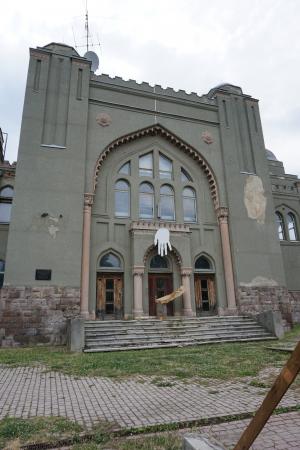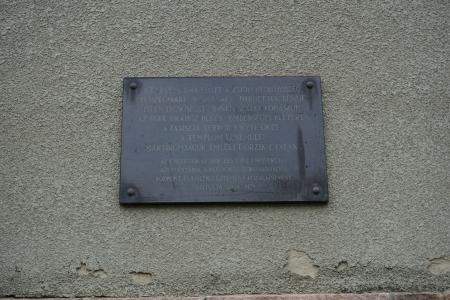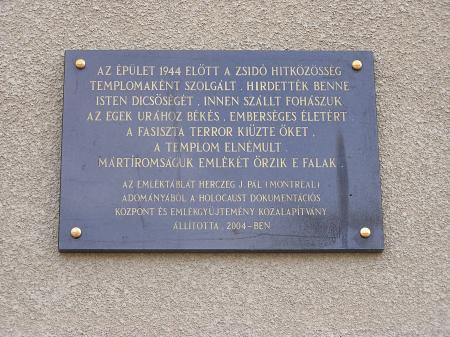Obj. ID: 47004
Jewish Architecture Holocaust memorial plaque at the Great (New) Synagogue in Győngyős, Hungary, 2004
To the main object: Great (New) Synagogue in Gyöngyös, Hungary

Memorial Name
No official name
Who is Commemorated?
Victims of the Holocaust from the Gyöngyös Jewish community
Description
This Memorial Plaque is a black stone rectangle attached to the former synagogue’s exterior wall, just to the left of the main entrance. The plaque is inscribed with gold lettering
Inscriptions
Hungarian:
AZ ĖPÜLET 1944 ELÖTT A ZSIDȮ HITKÖZÖSSĖG
TEMPLOMAKĖNT SZOLGALT. HIRDETTĖK BENNE
ISTEN DICSÖSEGĖT. INNEN SZÁLLT FOHÁSZUK
AZ EGEK URÁHOZ BĖKĖS. EMBERSĖGES ĖLETĖRT
A FASISZTA TERROR KIÜZTE ÖKET.
A TEMPLOM ELNĖMULT.
MÁRTIROMSÁGUK EMLĖKĖT ÖRZIK E FALAK.
AZ EMLĖKTABLAT HERCZEG J. PÁL (MONTREAL)
ADOMÁNYÁBȮL A HOLOCAUST DOKUMENTÁCIȮS
KÖZPONT ĖS EMLĖKGYÜJTEMĖNY KÖZALAPITVÁNY
ÁLLITOTTA. 2004 - BEN
Translation: Before 1944, the building served as a synagogue for the Jewish community where they offered prayers to the Lord in Heaven. The fascist terror ended their lives. The martyrs are remembered by these walls. / The memorial tablet was donated by J. Paul Herzog (Montreal) to the Holocaust Documentation Center and Memorial Collection in 2004.
Commissioned by
Mr. J. Paul Herzog of Montreal for the Holocaust Documentation Center and Memorial Collection Public Foundation (Budapest).
sub-set tree:
The large domed synagogue was designed by the prolific synagogue architect Lipot Baumhorn and his son-in-law György Somogyi, but it only served the community for a short time before the almost complete annihilation of the community during the Holocaust.
There were 2,429 Jews in Gyöngyös in 1941. In late May of 1944, the Jews of Gyöngyös and the surrounding areas were rounded up and forcibly moved to a ghetto where they were confined and used for forced labor. In June 1944 they were deported to Auschwitz. Only 461 of the town’s Jews survived the Holocaust. There were 300 Jews in Gyöngyös in 1946 and 414 in 1949. Most left in 1956. The synagogue was later used as a furniture warehouse. It was vacant and has been partially restored. Plans to develop the building as a cultural center have been presented but as of 2021, have not been implemented.
“Gyöngyös, Holocaust,”, https://kehilalinks.jewishgen.org/gyongyos/Gyongyos-Holocaust.htm (accessed April 23, 2023)
“Gyöngyös, Hungary,” JewishGen Kehilalinks., https://kehilalinks.jewishgen.org/gyongyos/ (accessed April 23, 2023)




